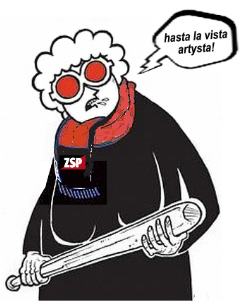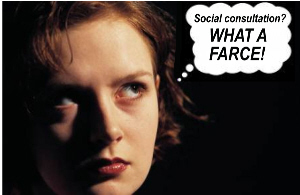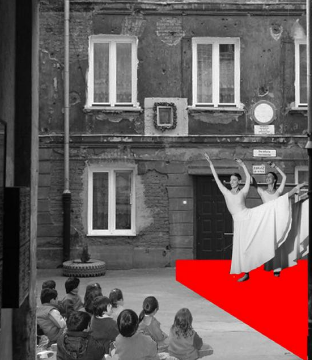Artists as the Useful Idiots of Gentrifiers
 The links between artistic settlement of depressed urban areas and its later gentrification are well known. As the area becomes "attractive" for the consumers of cultural product, and residency there imparts one with "coolness", rents go up.
The links between artistic settlement of depressed urban areas and its later gentrification are well known. As the area becomes "attractive" for the consumers of cultural product, and residency there imparts one with "coolness", rents go up.
Eventually even the most non-commercial and non-affluent of the bohemian settlers may be driven out. Some of these artist settlers see themselves on the same side of the economic barricade as "the people"; not being wealthy themselves, or with some contempt for the loathed yuppies and bourgeoisie, they are well aware of and are often against the gentrification process. It is hard for them then to come to terms with their role in it.
Art and cultural enterprises may be free, "popular", on the streets - but it is mainly a commercial product. Artistic entertainment is usually a form of business, thus places connected with "the art scene" are selling and profitting from cultural capital as much as landlords. Even free art on the streets can be recuperated into the "value" of a neighbourhood and ultimately benefit those with property and capital.
In Poland, there is a notable trend to talk about "revitalization" (as the gentrification process is locally called) being carried out in "social consulatation" with the locals, or to talk about programs which are meant to combat "social exclusion". But these social consultations are farces organized by the elites to involve a small group of "the people" in the co-management of the plan. Usually local people know nothing about them and they are attended by a small group of residents, often part of the cultural elite: artists, architects, the occasional sociologist or ecologist. There the authorities control whay may fit into the plan and what not. In the end, "the people" are given a sense of "participation" by being allowed to propose whether X will be painted yellow or pink, and which sort of accessories will be allowed to decorate public spaces. All is OK - as long as it raises the prestige and the commercial value of the neighbourhood.
 The residents of the Praga neighbourhood in Warsaw have been noticing this process but are largely kept out of it. Well-meaning sorts wishing to promote "community activity" would of course rather engage people. They fail largely because these consulations rarely address people's most pressing needs and because the people have long found themselves beaten down with every attempt they have made to improve their lives.
The residents of the Praga neighbourhood in Warsaw have been noticing this process but are largely kept out of it. Well-meaning sorts wishing to promote "community activity" would of course rather engage people. They fail largely because these consulations rarely address people's most pressing needs and because the people have long found themselves beaten down with every attempt they have made to improve their lives.
An example could be seen at a "social consultation" held a few months ago. A resident of Wilenska St. in Warsaw was one of the few who went there, hoping that "revitalization plans" would somehow improve the condition of her building. How does life look on Wilenska St.? You find that many, if not most of the buildings have no heating. The city prevents residents from moving into empty flats and do not want to put new residents there - because rather they prefer to get rid of people. People living next to empty flats which are never heated complain that no matter how much they try to heat, their flats are always cold. (Of course since heating properly can cost up to a full-month's retirement payment, few people are in a position to do some anyway.) There are flats without bathrooms, showers or kitchens. In many places, such "conveniences" exist only because people made them themselves.
And then there are raising rents and costs which many low-income and retired people cannot afford. Many live in fear that their building will wind up in private hands and they will be forced out of their homes.
The resident of Wilenska St. wanted to know what "revitalization" could be expected on her street. She was thinking about her building: holes in the staircase, no lock on the stairwell entrance, holes in the courtyard that gathered water and grew everytime it rained, faulty electrical installations, peeling paint and mold everywhere. Could she hope for some improvement?
Then she found out that revitalization was really like creating some Potemkin village: surely the facades of the buildings should be painted so they look nice for passersby. Other types of repair was not the job of the revitalizers.
The residents of Wilenska St. were recently surprised to learn that their street is the subject of interest not only of local artists, but international ones as well. The local papers recently announced the results of the 10th annual Europan competition. This year, artists and architects from around Europe, many of whom have never stepped foot on Wilenska St. submitted their projects for its improvement. While the architects picked up cash prizes for their ideas, many of the residents of Wilenska St. and thinking about whether they should heat their flats more or buy food this week.
The winners of the competition were some artsy architects from Madrid called MMasa, together with Scottish architects Stuart MacKellar and Michael Cooke. Reading through their project, one even sees that they have the residents in mind. (Except in keeping with artistic pretence, they refer to residents as "activists" and to the use of public space as "appropriation".) However one wonders how or even WHY anybody should give a shit about the social fantasies of artists from other cities, especially when there are plenty of locals who would have already carried out all these artsy projects if they just had the cash.
Not that all of the ideas are bad; the good use of public space should be on the agenda of local community activism. But many similar ideas have either already been proposed here or actually put into practice. Take, for example, a proposal from the winners to make gardens in courtyards. Local guerrila gardeners already do it, and many local residents have tried to create green spaces. There are only two problems: money and the attitude of residents. As it turns out, not all locals appreciate such projects, unless there is a sense of community in the building and the residents are directly involved in planning and implementing the project. Unfortunately, there is little sense of community in most buildings and in many places there is only antagonism. Antagonism not only towards neighbours, but towards the newcomers who are better positioned socially and culturally to withstand the gentrification process and who are brining it along with them.
Some attempts at creating gardens and leaving other decorative improvements were destroyed by local residents, leaving the do-gooders upset that the "local lowlife" do not understand or appreciate what is going on.
Local architects talk about how "changes" have to be planned with the locals. Only the continue to be ignorant to the fact that the "changes" they have in mind are, at least for now, only of limited use to most of the locals. The artsification of the neighbourhood is mostly for the artists themselves, then for a select group of local residents. In terms of priority of needs, most people would not put lack of artistic and cultural events on the top of their list.
 A few scenes from the winning project induced much laughter in Praga - particularly the ballet dancer in the courtyard of Wilenska St or the multigenerational outdoor discos in the yards that the artists imagine. Not that anybody is against dancing - it is just that community life has not evolved to that stage for most neighbourhoods. Some locals imagine that the most probable effects of putting a disco in the courtyard would be to piss each other off, with the local unemployed drunks making a racket at all hours of day and night and the working people, who tend to have little time for relaxing, loosing sleep.
A few scenes from the winning project induced much laughter in Praga - particularly the ballet dancer in the courtyard of Wilenska St or the multigenerational outdoor discos in the yards that the artists imagine. Not that anybody is against dancing - it is just that community life has not evolved to that stage for most neighbourhoods. Some locals imagine that the most probable effects of putting a disco in the courtyard would be to piss each other off, with the local unemployed drunks making a racket at all hours of day and night and the working people, who tend to have little time for relaxing, loosing sleep.
Ultimately, it is no surprise that the elites amuse themselves with such projects instead of investing in the vital infrastructure of the neighbourhood. That sort of investment is meant to be made by some fantasy future "investors", who having been convinced of the "potential" of the neighbourhood for making money, will buy things up and fix things up, even if this mean driving out the poor. In this context, the artists will not play the role of "saviours of the neighbourhood" for the local people, but rather are playing the role of the useful idiots of the gentrifiers.
Our Praga Blog: Stories of residents, photos, etc.
www.ourpraga.blogspot.com






